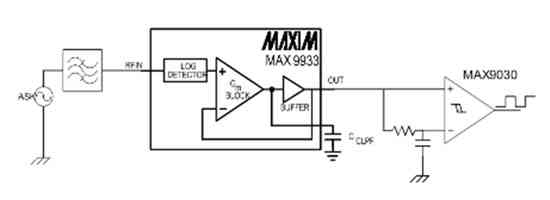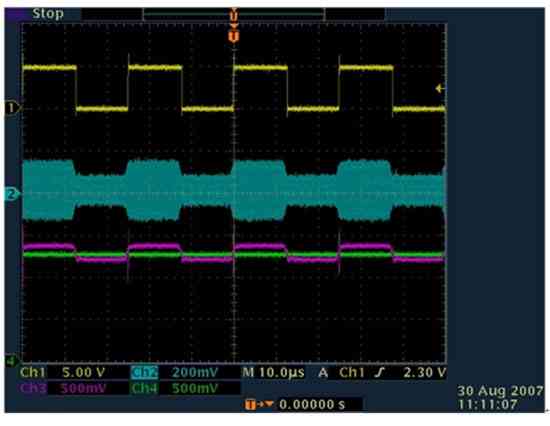Amplitude shift keying (ASK) is a digital communication modulation technique that is widely used in many low-frequency radio frequency applications. The simplest ASK method is when the signal source wants to send a '1', it sends a large-value carrier, and when it needs to send a '0', it sends a low-amplitude carrier. On-off keying (OOK) modulation is a further simplified version of this method. The signal source does not need to send a carrier when it needs to send a '0'.
ASK and OOK communication protocols are commonly used in short-range wireless communication applications, such as home automation, industrial networks, wireless base stations, remote keyless entry systems (RKE), and tire pressure monitoring systems (TPMS). OOK is particularly suitable for battery-powered portable devices, because such a system does not need to send a carrier when sending a '0', so it can save power. The carrier frequency involved in different applications may vary greatly. For example, it is about 2MHz in low-frequency wired communications in some base stations, and about 433MHz in short-range wireless communications using ISM bands (industrial, scientific, and medical).
Various wireless technologies, including Bluetooth, ZigBee, and Wi-Fi, have made some progress in the current consumer electronics industry. These protocols provide a mechanism for secure communication between devices. They usually work in the 2.4GHz ISM band and use a combination of frequency shift keying (FSK), phase shift keying (PSK), and amplitude shift keying (ASK) modulation techniques. . The security provided by these technologies includes channel frequency hopping and spread spectrum modes of communication. This scheme is difficult to be heard, so it has high security and can improve the anti-noise performance. All these methods consume transmission power when sending '0' and '1'. Unfortunately, these protocols still have relatively high complexity and high hardware implementation costs, especially when security and high noise immunity are not rigid requirements.
Wi-Fi is mainly used for high data rate and long-distance applications. For simple control + detection applications, it may be overkill. ZigBee is considered an ideal choice for emerging sensor networks, and Bluetooth is widely used in numerous consumer audio devices and personal wireless devices. Table 1 makes a simple comparison of different performance characteristics of Bluetooth, ZigBee and ASK / OOK methods.

Table 1: Comparison of Bluetooth, ZigBee and ASK / OOK features
However, the simple implementation of ASK / OOK hardware has become the preferred choice due to its low cost, especially in battery-powered applications with very long usage times, or where access point-to-point wired basic networks and wireless infrared links are possible. For different applications, the implementation cost of other technologies may be 2 to 5 times it. By implementing a two-way interrogation mechanism between the transmitter and receiver, sufficient security can still be achieved on this link, for example by exchanging special codes if necessary. Compared with OOK, ASK can provide better anti-noise performance, and the cost is lower than FSK, but the power consumption is higher than OOK.
1 The application of MAX9933 in the signal chain of ASK receiver
The ASK receiver front-end usually consists of three modules: an input band-pass filter used to distinguish the carrier frequency of interest from the broadband input noise spectrum, an envelope detector used to extract the information of interest, and a binary output used to generate the binary output Comparators. The trigger threshold level of the comparator comes from the output of the envelope detector itself; this allows the threshold level to be adjusted automatically with the received signal level.
One possible implementation of the front end is to use the RF power detector MAX9933, which can read input signals with a dynamic range of 45dB and a frequency of 2MHz to 1.6GHz. In particular, it can output a logarithmic voltage proportional to the signal level ranging from -58dBV to -13dBV (that is, 1.25mVrms to 223mVrms). Figure 1 shows the application of MAX9933 in the ASK receiver signal chain.

Figure 1: The application of MAX9933 in the ASK receiver signal chain
The RF signal fed into the FRIN pin is AC coupled externally. Because the MAX9933 is a peak-response RF detector, its basic function is a simple envelope detector, even for signals as low as millivolts. The logarithmic transfer function for the amplitude of the input RF voltage relative to the output DC voltage is proportional to dB, so the MAX9933 is very sensitive to very small signals, allowing the ASK receiver to easily distinguish between the input 1 and 0 signal levels. The value of the capacitor CCLPF determines the response bandwidth of the chip output, which in turn depends on the expected data rate. Figure 2 shows the output waveform when testing the power detector as an envelope detector, where the comparator uses an adaptive reference to generate digital output bits. The test waveform has a carrier frequency of 10 MHz and a data rate of 40 kbps. The CCLPF filter capacitor is 150pF, and the RC filter consists of a 100kΩ resistor and a 0.22μF capacitor.

Figure 2: The response of the MAX9933 RF detector to an RF input signal with a modulation frequency of 10MHz and a data rate of 40kbps.
Double Sided Pcb,Double-Layer Circuit Boards,Double-Layer Pcb Circuit Board,Double Sided Circuit Board
Shenzheng Weifu Circuit Technology Co.Ld , https://www.viafoem.com